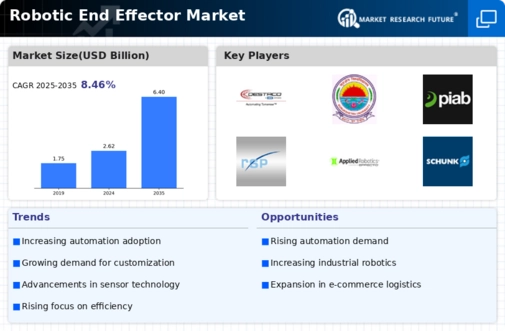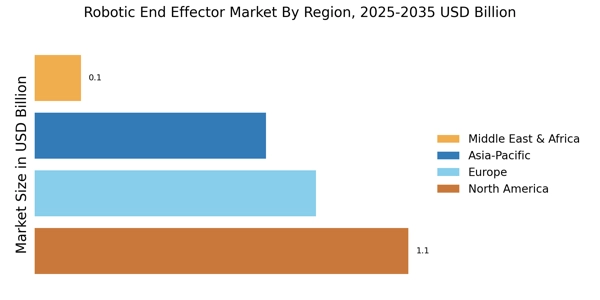Expansion of E-commerce and Logistics
The rapid expansion of e-commerce is reshaping the logistics landscape, thereby influencing the Robotic End Effector Market. As online shopping continues to grow, the need for efficient warehousing and order fulfillment solutions becomes increasingly important. Robotic systems equipped with specialized end effectors are being deployed to automate sorting, packing, and shipping processes. This shift is expected to drive the market for robotic end effectors, with projections indicating a growth rate of 12% in the logistics sector over the next few years. The integration of robotics in logistics not only enhances efficiency but also addresses labor shortages in the industry.
Technological Advancements in Robotics
Technological innovations are significantly influencing the Robotic End Effector Market. The development of sophisticated sensors, artificial intelligence, and machine learning algorithms is enhancing the capabilities of robotic systems. These advancements allow for more precise and adaptable end effectors, which can perform a wider range of tasks. For instance, the introduction of smart grippers that can adjust their grip based on the object being handled is revolutionizing material handling processes. The market for robotic components is expected to reach USD 20 billion by 2026, indicating a robust growth trajectory fueled by these technological enhancements.
Growing Need for Precision in Healthcare
The healthcare sector is increasingly recognizing the value of robotic solutions, which is positively impacting the Robotic End Effector Market. The demand for precision in surgical procedures and patient care is driving the adoption of robotic systems equipped with advanced end effectors. These devices enable surgeons to perform complex tasks with enhanced accuracy, thereby improving patient outcomes. The market for surgical robots is anticipated to grow significantly, with estimates suggesting a value of USD 12 billion by 2025. This trend underscores the critical role that robotic end effectors play in advancing healthcare technologies.
Rising Demand for Automation in Manufacturing
The Robotic End Effector Market is experiencing a surge in demand driven by the increasing need for automation in manufacturing processes. Industries are increasingly adopting robotic solutions to enhance productivity, reduce labor costs, and improve precision. According to recent data, the automation market is projected to grow at a compound annual growth rate of approximately 10% over the next five years. This trend is particularly evident in sectors such as automotive and electronics, where efficiency and speed are paramount. As manufacturers seek to streamline operations, the integration of advanced robotic end effectors becomes essential, thereby propelling the market forward.
Increased Investment in Research and Development
Investment in research and development is a critical driver for the Robotic End Effector Market. Companies are allocating substantial resources to innovate and improve robotic technologies, which is essential for maintaining competitive advantage. This focus on R&D is leading to the creation of more efficient and versatile end effectors that can cater to diverse applications across various sectors. As organizations strive to enhance their operational capabilities, the demand for advanced robotic solutions is likely to rise. The R&D expenditure in robotics is projected to increase by 15% annually, reflecting the industry's commitment to innovation.

















Leave a Comment